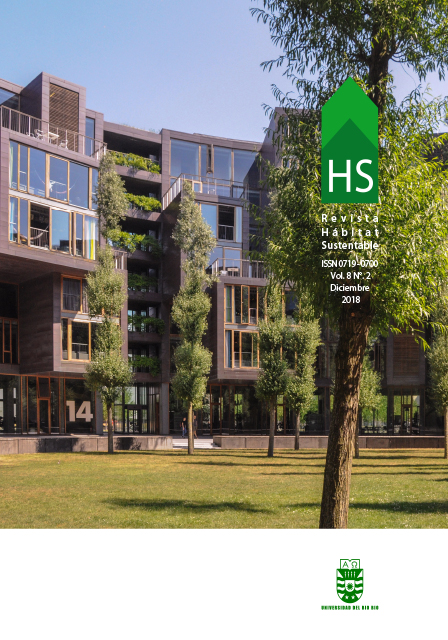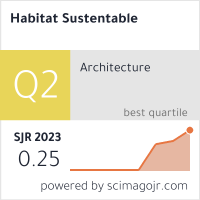Termografía infrarroja para el diagnóstico térmico confiable con alta replicabilidad y bajo costo de viviendas en Mendoza, Argentina
DOI:
https://doi.org/10.22320/07190700.2018.08.02.06Palabras clave:
diagnóstico, temperatura, viviendas apareadasResumen
El objetivo de este trabajo es valorar la utilidad de la termografía infrarroja para diagnosticar en forma rápida el desempeño térmico de edificios existentes. Se seleccionó, para ello, un caso de estudio representativo de vivienda en la ciudad de Mendoza (32o40’LS, 68o51’LO, 750msnm) y se procedió a la toma de imágenes termográficas con una cámara de bajo costo (FLIR i3), en dos momentos del día: en la tarde-noche (8 pm) y en la mañana, temprano, (7am), de modo de evitar posibles errores debidos a la incidencia de radiación solar directa. La emisividad se introdujo en la cámara de acuerdo con estudios de materiales locales. Al mismo tiempo, se realizaron mediciones continuas de temperatura del aire dentro y fuera de la vivienda con micro-adquisidores, con el objeto de contrastar los resultados obtenidos mediante la exploración termográfica. Dado que el caso de estudio tiene una inercia térmica alta, las imágenes tomadas durante la tarde-noche muestran en una mayor medida los distintos comportamientos de los materiales de construcción. Se concluye que la termografía infrarroja resulta una herramienta valiosa para un diagnóstico térmico rápido en la certificación edilicia, si se sigue un protocolo específico que permita obtener resultados confiables.
Descargas
Citas
ANDERSEN, Micaela; DÍSCOLI, Carlo Alberto; VIEGAS, Graciela Melisa y MARTINI, Irene. Monitoreo energético y estrategias de RETROFIT para viviendas sociales en clima frío, Revista Hábitat Sustentable, 2017, vol.7, n° 2, pp. 50-63.
ANDREONI TRENTACOSTE, Soledad Elisa y GANEM KARLEN, Carolina. Influencia del uso y gestión de la envolvente en el comportamiento térmico de verano de una vivienda en la ciudad de Mendoza, Argentina, Revista Hábitat Sustentable, 2017, vol.7, n° 2, pp. 64-75.
COSTILLA SANZ, Carlos. Aplicación práctica para cámara IR (Infrarrojos). Proyecto fin de carrera. Trabajo fin de grado, E.T.S.I. y Sistemas de Telecomunicación (UPM), Madrid, 2017.
DE PRADA PÉREZ DE AZPEITIA, Fernando Ignazio. La termografía infrarroja: un sorprendente recurso para la enseñanza de la física y la química, Revista Eureka sobre Enseñanza y Divulgación de las Ciencias, 2016, vol. 13, pp. 617-627.
DUFFIE, John A. y BECKMAN, William A. Solar Engineering and Thermal Processes. 2da edición. New York: John Wiley & Sons, 1991.
FLIR. Guía sobre termografía para aplicaciones en edificios y energía renovable [en línea]. [Consultado: 12 noviembre 2018] Disponible en: http://www.flirmedia.com/MMC/THG/ Brochures/T820325/T820325_ES.pdf
FLORES LARSEN, Silvana y HONGN, Marcos. Termografía infrarroja en la edificación: aplicaciones cualitativas, Avances en Energías Renovables y Medio Ambiente, 2012, vol. 16, pp. 8.25-8.32.
FOX, Mathew; COLEY, David; GOODHEW, Steve y DE WILDE, Pieter. Time-lapse thermography for building defect detection, Energy and Buildings, 2015, vol. 92, pp. 95-106.
FOX, Mathew; GOODHEW, Steve y DE WILDE, Pieter. Building defect detection: External versus internal thermography, Building and Environment, 2016, vol. 105, pp. 317-331.
GANEM, Carolina; BAREA, Gustavo y BALTER, Julieta. Infrared Thermography for Quick Thermal Diagnostic of Existing Building. En: Proceedings of PLEA 2016 (Los Ángeles, 11-13 de Julio de 2016) Cities, Buildings, People: Towards Regenerative Environments. Los Ángeles, 2016.
GEIGER R. y POHL W. Revision of Koeppen-Geiger climate maps of the Earth. Germany: Justus Perthes, 1953.
INDEC. Censo Nacional de Población, Hogares y Viviendas 2010 [en línea]. [Consultado 8 noviembre 2018]. Disponible en: https://www.indec.gob.ar.
KIRIMTAT, Ayca y KREJCAR, Ondrej. A review of infrared thermography for the investigation of building envelopes: Advances and prospects, Energy and Buildings, 2018, vol. 176, pp. 390-406.
KYLILI, Angeliki; FOKAIDES, Paris A.; CHRISTOU, Petros y KALOGIROU, Soteris A. Infrared thermography (IRT) applications for building diagnostics: A review. Applied Energy, 2014, vol. 134, pp. 531-549.
LUCCHI, Elena. Applications of the infrared thermography in the energy audit of buildings: A review, Renewable and Sustainable Energy Reviews, 2018, vol. 82, n° 3, pp. 3077- 3090.
MARTÍN OCAÑA, Silvia; CAÑAS GUERRERO, Ignacio y GONZÁLEZ REQUENA, Ignacio.Thermographic survey of two rural buildings in Spain, Energy and Buildings, 2004, vol. 36, pp. 515-523.
MOHR Peter J., TAYLOR Barry N. y NEWELL David B. CODATA Recommended Values of the Fundamental Physical Constants: 2006, Review of Modern Physics, 2008, vol. 80, pp. 715.
NARDI, Inole; LUCCHI, Elena; DE RUBEISA, Tullio y AMBROSINIA, Dario. Quantification of heat energy losses through the building envelope: A state of-the-art, Building and Environment, 2018, vol. 146, pp. 190-205.
PORRAS-AMORES, César; MAZARRÓN, Fernando S. y CAÑAS, Ignacio. Using quantitative infrared thermography to determine indoor air temperature, Energy and Buildings, 2013, vol. 65, pp. 292-298.
ROCHA, J. H. A.; SANTOS, C.F. y PÓVOAS, Y.V. Evaluation of the infrared thremography technique for capillarity moisture detection in buildings, Procedia Structural Integrity, 2018, vol. 11, pp. 107-113.
SCHNEIDER, Lucas. Las 25 recomendaciones de la IEA en políticas públicas sobre eficiencia energética. Observatorio de la Energía, Tecnología e Infraestructura para el Desarrollo [en línea]. 2015, junio. [Consultado 01 noviembre 2018]. Disponible en: http://www.oetec.org/nota.php?id=1258&area=7
TEJEDOR, Beatriz; CASALS, Miguel; GANGOLELLS, Marta y ROCA, Xavier. Quantitative internal infrared thermography for determining in-situ thermal behaviour of façades. Energy and Buildings, 2017, vol. 151, pp. 187-197.
THOUVENEL, Julie. Find a modern and quick method to determine the U value and the thermal characteristics of a building envelope using an IR camera [en línea]. Master of ScienceThesis.
KTH School of Industrial Engineering and Management. Energy Technology. Stockholm, 2012. [Consultado 1 noviembre 2018]. Disponible en: http://kth.diva-portal.org/smash/get/ diva2:603444/FULLTEXT01
Descargas
Publicado
Cómo citar
Número
Sección
Licencia
El contenido de los artículos que se publican en cada número de Hábitat Sustentable, es responsabilidad exclusiva de los autores y no representan necesariamente el pensamiento ni comprometen la opinión de la Universidad del Bío-Bío.
Los autores/as conservarán sus derechos de autor y garantizarán a la revista el derecho de primera publicación de su obra, el cuál estará simultáneamente sujeto a la Licencia de Reconocimiento de Creative Commons CC BY-SA que permite a otros compartir-copiar, transformar o crear nuevo material a partir de esta obra con fines no comerciales, siempre y cuando se reconozcan la autoría y la primera publicación en esta revista, y sus nuevas creaciones estén bajo una licencia con los mismos términos.











 Programa de Información Científica/Concurso Fondos de Publicación de Revistas Científicas 2018/ Proyecto Mejoramiento de Visibilidad de Revistas UBB (Código:FP180007)
Programa de Información Científica/Concurso Fondos de Publicación de Revistas Científicas 2018/ Proyecto Mejoramiento de Visibilidad de Revistas UBB (Código:FP180007) 





